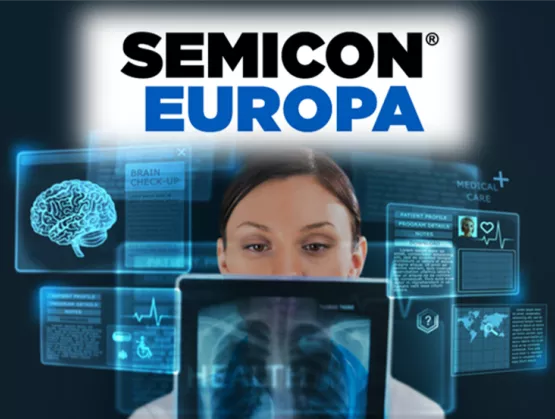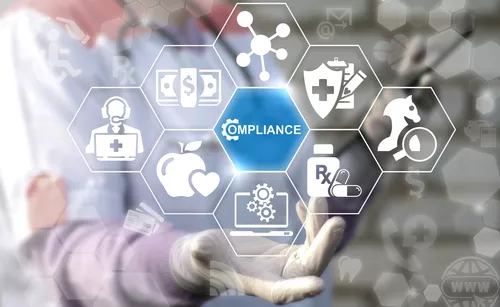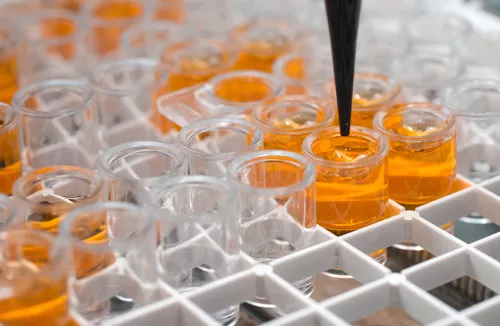
According to the Organisation for Economic Co-operation and Development (OECD), healthcare is among the biggest sectors in industrialized countries, accounting for 8.8 percent of global GDP in 2017. SEMI spoke with Michael Strübin, Director of Digital Health at MedTech Europe, about medical technology trends, regulatory issues, cybersecurity and how healthcare systems are moving towards a sustainable path through improvements in areas such as prevention of illness, patient empowerment, lean systems and low-carbon alternatives.
Strübin shared his views ahead of his presentation at the SEMI SMART MedTech Forum at SEMICON Europa, 12-15 November, 2019, in Munich, Germany. Meet experts from MedTech Europe and other key industry influencers at the forum, 13-14 November, in Hall B2 (Inspiration Hub). Participation is free of charge for SEMICON Europa visitors. SEMICON Europa registration is open.
SEMI: When did you join MedTech Europe?
Strübin: I joined MedTech Europe just a bit over a year ago and it’s been an exciting adventure. I started working on digital health when it was still called eHealth (we were getting rid of the term health telematics at the time) and have been working on digital health and personal connected health systems and their integration into healthcare systems. A vexing issue there has been the challenge of technical interoperability. In my work for the Continua Health Alliance, we focused on raising awareness about the role of standards and specifications for personal connected care. The Continua Health Alliance is an international non-profit, open industry group of nearly 240 healthcare providers and communications, medical, and fitness device companies.
SEMI: Tell us more about the MedTech Europe vision and mission.
 Strübin: MedTech Europe is the European trade association for the medical technology industry. Our members make medical and diagnostic devices as well as products and solutions in digital health. We make innovative medical technology available to more people, while helping healthcare systems move towards a more sustainable path. We are the voice of the medical technology industries in Europe and beyond.
Strübin: MedTech Europe is the European trade association for the medical technology industry. Our members make medical and diagnostic devices as well as products and solutions in digital health. We make innovative medical technology available to more people, while helping healthcare systems move towards a more sustainable path. We are the voice of the medical technology industries in Europe and beyond.
SEMI: MedTech Europe engages with EU regulators, politicians and other decision-makers to help shape policies to promote innovation that meets healthcare's growing needs. What is MedTech Europe’s role?
Strübin: MedTech Europe represents the medical technology industry here in Brussels, and we participate in discussions relevant to our industry.
Our overall aim is to advocate for regulations that ensure the safety and efficacy of products provided to patients. We provide legislators with expert insights that enable legislators to make informed decisions. Policymakers regularly invite us to participate in meetings, answer questions or provide them with background information on our industry.
SEMI: New medical device regulations will come into force in the coming years. What challenges will these regulations address?
Strübin: The Medical Device Regulation (MDR) and the In Vitro Diagnostics Device Regulation (IVDR) were both enacted in 2017 and will go into effect in 2020 and 2022, respectively. Our industry has long backed the new regulations, which build on and strengthen earlier sets of rules. Supporting strong EU legislation focused on patient and user safety has always been a key pillar of our work.
 Our priority is to see the new MDR regulatory system function efficiently, and to ensure the continued availability of medical devices needed by patients and hospitals in Europe. Our industry is prepared to submit product files to comply with the new regulation. Product files include detailed descriptions of design records, manufacturing processes, product specifications, device usage guidelines, quality measurement criteria, levels of compliance with regulatory bodies and quality standards, and, if required, servicing and installation records. However, we see challenges in implementing the regulation. If key elements of the new regulatory system are not clear, bottlenecks and other risks undermine the potential to foster a continued high level of care. We are working with all stakeholders to address the issues and explore mitigating actions.
Our priority is to see the new MDR regulatory system function efficiently, and to ensure the continued availability of medical devices needed by patients and hospitals in Europe. Our industry is prepared to submit product files to comply with the new regulation. Product files include detailed descriptions of design records, manufacturing processes, product specifications, device usage guidelines, quality measurement criteria, levels of compliance with regulatory bodies and quality standards, and, if required, servicing and installation records. However, we see challenges in implementing the regulation. If key elements of the new regulatory system are not clear, bottlenecks and other risks undermine the potential to foster a continued high level of care. We are working with all stakeholders to address the issues and explore mitigating actions.
With IVDR, there is still a lot of work to be done around implementation. Here, too, our primary concern is the readiness of the Notified Body system for IVDs. A Notified Body is an independent certification organization that is notified by a European Member State's Competent Authority to determine if a product or system meets applicable requirements for Conformité Européenne (CE) marking, a certification of conformity with health, safety, and environmental protection standards for products sold within the European Economic Area. The regulation foresaw a five-year transition period before it takes effect. Due to the increase of requests for IVD and the very limited availability of notified bodies, actions must be taken to implement the new regulatory system faster and more efficiently.
SEMI: What is the difference between medical devices and In Vitro Diagnostic devices?
 Strübin: A medical device can be anything used in medical practice for the diagnosis, prevention, monitoring, treatment, or alleviation of a disease. Medical devices range from wooden spatulas, syringes and wheelchairs to cardiac pacemakers and medical imaging technologies.
Strübin: A medical device can be anything used in medical practice for the diagnosis, prevention, monitoring, treatment, or alleviation of a disease. Medical devices range from wooden spatulas, syringes and wheelchairs to cardiac pacemakers and medical imaging technologies.
In Vitro Diagnostics (IVDs), on the other hand, are non-invasive tests used on samples to determine the status of a person’s health. Examples include an HIV test or a glucose monitor that gives you information about your blood sugar level.
SEMI: Where are the main medical technology market opportunities in Europe?
Strübin: The European medical technology market is estimated at roughly €115 billion (our latest figures are for 2017). The biggest markets are of course those with the biggest economies. Germany, France, the UK, Italy and Spain top the list. In 2017, Europe exported almost €20 billion worth of medical technologies more than it imported. Most, about 40 percent, went to the United States and 10 percent to China, followed by Japan, Russia and other countries.
SEMI: Fragmentation, the public sector, and the high level of regulation present challenges for the medtech industry. What is your position on these headwinds?
Strübin: Healthcare is different than other sectors in that the guarantee of universal coverage requires heavy public sector involvement. The user is most often not the customer and access to the market is heavily regulated. Because the healthcare sector is fragmented, it is difficult to realize economies of scale. That said, few sectors offer the opportunity to make peoples’ lives better in such tangible ways.
The Healthcare sector is unique and still an incredibly fragmented industry where the competing interests of different players including medical device makes, patients, doctors and regulators aren’t always easy to align. The regulation of our industry is ultimately intended to provide patients with devices that are safe and work. In Europe, the new Medical Device Regulation strengthens the high safety standards in this already highly regulated industry. We take our responsibility to comply with these regulations very seriously as it is our responsibility to do so for the patients we serve.
 SEMI: What are your expectations for the SMART MedTech Forum at SEMICON Europa 2019 in Munich?
SEMI: What are your expectations for the SMART MedTech Forum at SEMICON Europa 2019 in Munich?
Strübin: I look forward to discussions and interactions with people who do not come from the usual Brussels bubble.
SEMI: Can you share one prediction for the future of medtech digital solutions?
Strübin: The future of medical devices will be shaped by digital transformation and data. Making information available where and when it is needed will make healthcare safer and more efficient. People with chronic conditions will be able to manage their lives with the help of sensors and applications and spend less time in hospitals and doctors’ offices. New apps, algorithms and robots powered by artificial intelligence (AI) will take over more and more of the routine tasks in healthcare, and free healthcare professionals to focus their efforts where they are needed most.
Genomic sequencing and longitudinal data will give us new insights into health, metabolism, and disease so we can offer more personalized and effective treatments. With powerful 5G connections, doctors will also be able to perform surgery remotely. The future of healthcare is digital.
 Michael Strübin joined MedTech Europe as Digital Health Director in 2018 to help develop the industry’s voice in the digital health field and to represent MedTech Europe’s members vis-à-vis digital health policymakers and stakeholders. Prior to MedTech Europe, Michael ran the European operations of the Continua Health Alliance (renamed Personal Connected Health Alliance in 2014), an international association of health and technology companies, governments and research organisations to advance personal connected health. From 2006 to 2008, Michael was the first European Director of the Health Information and Management Systems Society (HIMSS). Michael studied political science and humanities in Germany and the United States, and worked in international development and philanthropy. He has been based in Brussels since 2003.
Michael Strübin joined MedTech Europe as Digital Health Director in 2018 to help develop the industry’s voice in the digital health field and to represent MedTech Europe’s members vis-à-vis digital health policymakers and stakeholders. Prior to MedTech Europe, Michael ran the European operations of the Continua Health Alliance (renamed Personal Connected Health Alliance in 2014), an international association of health and technology companies, governments and research organisations to advance personal connected health. From 2006 to 2008, Michael was the first European Director of the Health Information and Management Systems Society (HIMSS). Michael studied political science and humanities in Germany and the United States, and worked in international development and philanthropy. He has been based in Brussels since 2003.
Serena Brischetto is senior manager, marketing and communications, at SEMI Europe.